By Eric Vandenbroeck
and co-workers
Allies Are Beefing Up Defenses In The Pacific
The provocative actions
taken by China, North Korea, and Russia have prompted the United States and its
closest allies in the Indo-Pacific to ramp up military capabilities and deepen
their cooperation. “They’re bolstering their defenses, they’re looking to
strengthen their alliances and partnerships with the United States in
particular, and they’re reaching out to each other,” said Ely Ratner, assistant
secretary of defense for Indo-Pacific security affairs. “All of these things
are happening at once.”
The trend, the Biden
administration says, reflects efforts to create a free and prosperous
Indo-Pacific through the steady forging of partnerships — moving toward what it
calls a “latticework” of mutually reinforcing coalitions.
Much of the progress
is becoming evident only recently.
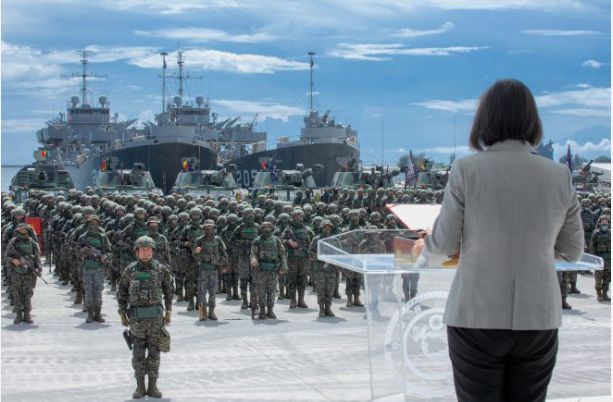
In December, Japan
announced it would massively hike its defense budget and buy U.S.-made Tomahawk
cruise missiles. The Philippines this month said it would allow U.S. troops to
access four additional military sites in the country. And Australia is expected
in the coming weeks to unveil a path forward to acquire nuclear-powered
submarines with the help of the United States and Britain — a plan, officials
said, that is likely to include rotational deployment of U.S. submarines in
Australia to help the navy there train its crews.
At the same time,
some countries are wary of being seen as aligned too closely with the United
States. For instance, Thailand, Malaysia, and Indonesia focus on avoiding
crossfire in the great-power competition and say they do not wish to be forced
to choose between China and the United States.
India, an important
partner in the Biden administration’s Indo-Pacific strategy, has been willing
to cooperate with the United States in military exercises, most recently in
defense technology. But, keen to preserve its policy of strategic autonomy, it
has avoided becoming part of any multilateral security arrangement or joining
any coalition to pressure Russia or China.
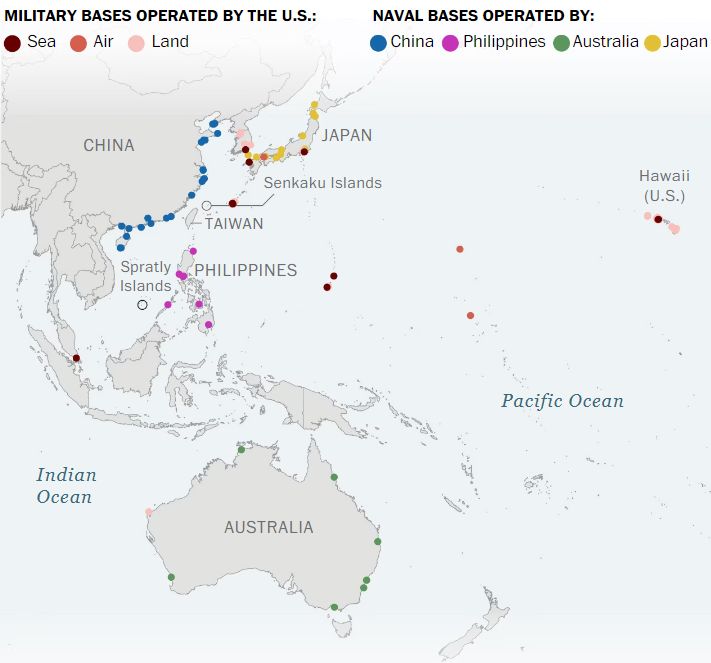
Meanwhile, Russia’s
invasion of Ukraine and China’s eye-watering military growth — already boasting
the world’s largest navy and last year conducting more ballistic missile tests
than the rest of the world combined — has stoked regional fears that a Chinese
invasion of Taiwan is a possibility. Though it might not be imminent, some top
U.S. generals warn that American troops must be ready.
Indeed, the United
States itself, Aquilino said, needs to improve its force posture in the region.
“Everything needs to go
faster,” he said. Everyone needs “a sense of urgency because that’s what it’s
going to take to prevent a conflict.”
Admiral John C.
Aquilino, left, commander of the U.S. Indo-Pacific Command, looks at videos of
Chinese structures and buildings on board a U.S. P-8A Poseidon reconnaissance
plane flying over the Spratly Islands in the South China Sea on 20 March 2022
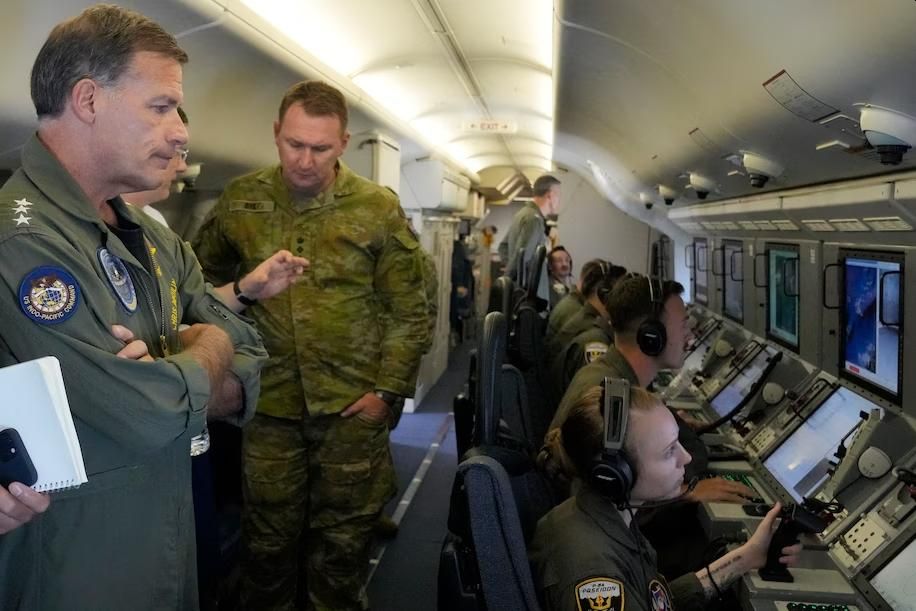
A New Forward-Leaning Security Projection
In the commander’s foyer
sits a 3D model of an artificial island built by the Chinese atop a reef in the South China Sea. It’s outfitted with a
3,000-meter runway and fighter jet hangars. For scale, a replica of the
Pentagon fits in the island’s harbor, dwarfed by the 680-acre island
constructed several years ago by the Chinese military.
It’s a reminder of
how quickly China has expanded its military reach into the region, rattling
neighbors such as Taiwan, Vietnam, and the Philippines.
Chinese structures and buildings on the man-made Fiery
Cross Reef in the disputed Spratly Islands in the South China Sea.
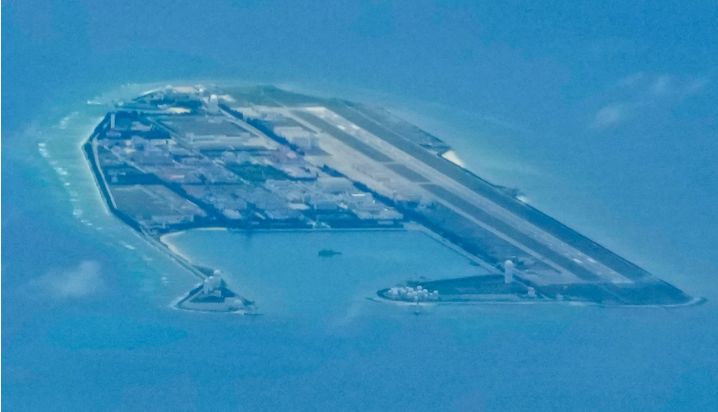
It’s a reminder of
how quickly China has expanded its military reach into the region, rattling
neighbors such as Taiwan, Vietnam, and the Philippines.
“It’s having an
effect,” Aquilino said. “Nations are operating in ways they haven’t operated
before.”
He pointed to a
six-nation exercise in the Philippine Sea in October 2021 that came together
with such speed and stealth that it had no name. It featured the U.S. carriers
Carl Vinson and Ronald Reagan and the British carrier Queen Elizabeth, a
Japanese carrier and a Dutch destroyer, synchronizing with aircraft and undersea
maneuvers and space and cyberspace operations.
European and NATO
countries, too, are concerned about the growing threats in the Indo-Pacific.
Last summer, Aquilino’s
command completed the largest-ever maritime exercise off the Hawaiian Islands
and Southern California with 26 nations, several dozen ships, three submarines,
170 aircraft, and more than 25,000 personnel. Participants included Chile,
Indonesia, Tonga, France, Germany, India, and Japan.
Japan, in particular,
has come a long way in a short time in acknowledging the regional threat China
and North Korea pose. In December, it abandoned a half-century of restrained
defense spending and committed to nearly doubling its defense budget over five
years — making it the world’s third largest. It also announced it would develop
a counterstrike missile capability. Japanese officials, for domestic political
purposes, downplay the shift as defensive.
In this handout
photo, members of the Japan Ground Self-Defense Force 5th Surface-to-Surface
Missile regiment stand by for inspection during the Rim of the Pacific 2022
exercise on 16 July 16, 2022, in Hawaii.
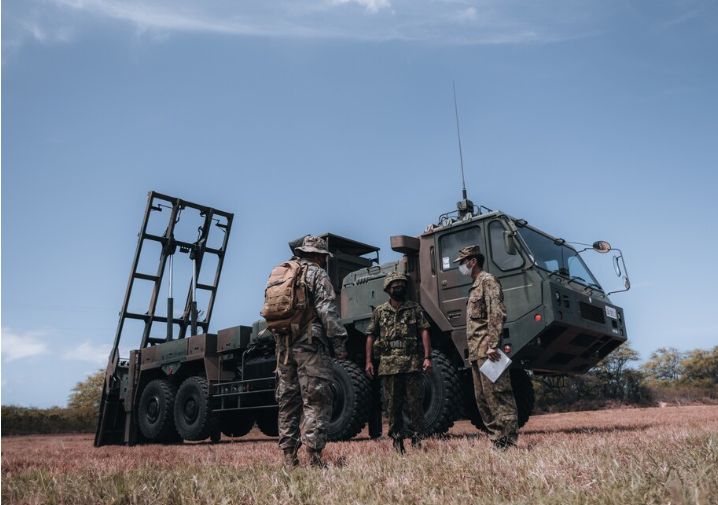
But they are candid
about the urgency.
“The reason we have
to put up arms is because of the increasingly severe and complex security challenges
in the region, which are posed by North Korea, China, and Russia,” Noriyuki Shikata, Prime Minister Fumio Kishida’s Cabinet press
secretary, said in an interview. “Given the security landscape in Asia, we must
respond by building up our defenses. So we need to improve our deterrence
capabilities.”
Along with the
Tomahawk cruise missiles, which can reach mainland China, Japan has agreed to
let the U.S. Marine Corps revamp a unit in Okinawa so that they can rapidly
disperse to fight in remote islands closer to Taiwan. This new Marine littoral
regiment will be equipped with anti-ship missiles that could, experts say, be
fired at Chinese ships in a Taiwan contingency.
Tokyo also intends to
integrate its self-defense forces into U.S. military exercises in Australia, a
deepening of the trilateral security arrangement that officials say is
emblematic of a growing latticework.
For instance, North
Korea’s provocations have drawn long-standing rivals South Korea and Japan
closer, and an emerging partnership links the United States, the Philippines,
and Japan. Philippine President Ferdinand Marcos Jr. visited Tokyo this month
and signed several agreements, including on defense cooperation.
South Korean Marine
Corps soldiers at a military checkpoint on Baengnyeong
Island, South Korea, on March 30, 2021. Since the fighting ended in the Korean
War nearly seven decades ago, Baengnyeong has been a
key location for U.S. allies in Seoul to spy on North Korea.
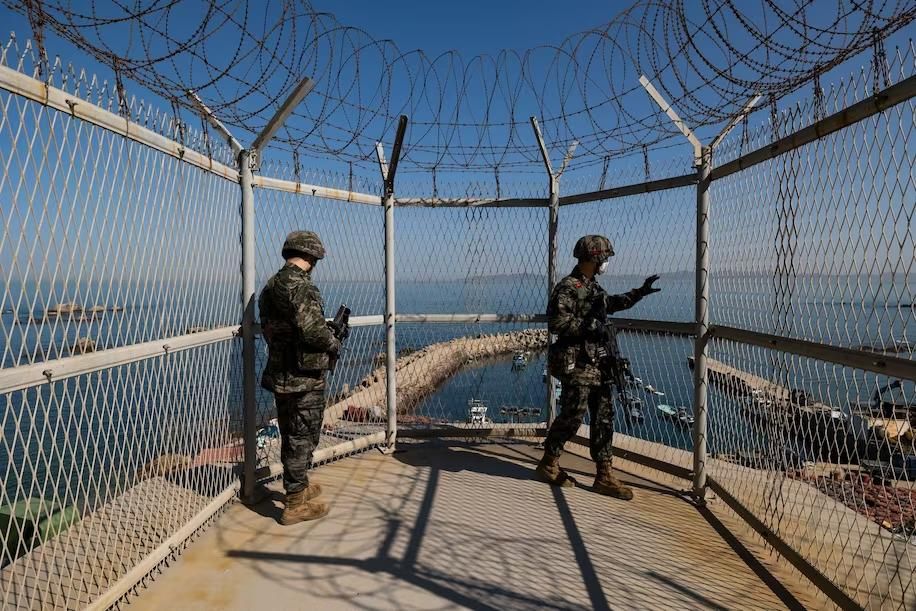
The last year has
been “an incredible inflection point” for countries like Japan, said Rahm
Emanuel, the U.S. ambassador in Tokyo. “Japan has gone from a mindset of
alliance protection to alliance projection. That is the new paradigm for the
United States, Japan, and the region.”
Australia is expected
in the coming weeks to unveil a plan with the United States and Britain to help
it develop nuclear-powered submarines. When the subs are built and operating,
which officials say will likely be sometime in the 2030s, the initiative,
referred to as AUKUS, will be one of the region's
most significant force modernization efforts.
“The progress has
been substantial,” said one U.S. official, who spoke anonymously because of the
matter’s sensitivity. “They’re moving closer to a major announcement. Not only
will this involve the mechanics and finances around building a submarine, but
it will also have substantial elements of joint crew training, facilities
maintenance, and other areas of integration that promise to bring the three
navies ever closer together.”
President Biden,
joined by Australian Prime Minister Scott Morrison and British Prime Minister
Boris Johnson, announced on 15 Sept. a new Indo-Pacific alliance.
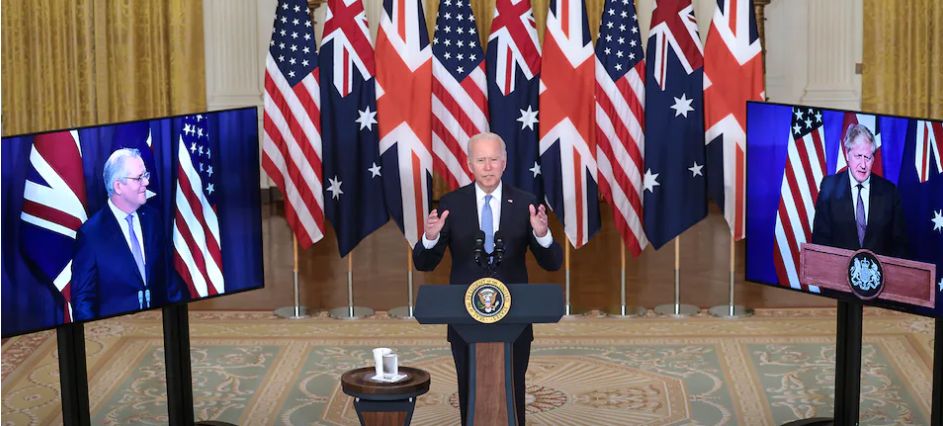
Deploying U.S.
nuclear submarines in Australia — even on a rotational basis — would be
significant, experts say, as a base in the Indian Ocean would be outside the
range of most Chinese missiles. “But the main reason it would be significant is
it would show the Australians are serious about getting ready to deploy their
nuclear-powered subs,” said Michael J. Green, chief executive of the United
States Studies Center at the University of Sydney and a White House Asia aide
in the George W. Bush administration.
The AUKUS deal has
angered the Chinese, who view it as a deliberate provocation and accuse the
United States and partners of trying to contain China through an “Anglo-Saxon
clique.” China’s Foreign Ministry has attacked the arrangement as potentially
undermining the international nuclear nonproliferation regime.
Australia notes that
the Non-Proliferation Treaty does not bar a nonnuclear weapon state from
acquiring naval nuclear propulsion technology. The Australian submarines would
not carry nuclear weapons. A foreign affairs department spokesperson said AUKUS
“will be fully consistent” with the treaty.
Seeking To Stay Out Of The Fray
Not all countries are
as eager to trumpet their deeper defense cooperation ties with the United
States — or China, for that matter.
In Thailand, a
long-standing ally in Southeast Asia, defense officials said that the United
States appeared to be paying more attention to the region as China ramps up its
efforts to expand its influence. But Lt. Gen. Kongcheep
Tantravanich, a spokesman for the Defense Ministry,
said Thailand did not want to be “manipulated” by either country.
“We have to maintain
our status as neutral,” Kongcheep said from Bangkok.
Thailand last year
said it would purchase a significant amount of military equipment from the
United States and begin a program — the first of its kind between the two
countries — to share information on defense technologies. The program will also
naturally lead to the exchange of military personnel, said Panitan
Wattanayagorn, chief of the Thai government’s
security affairs committee. “We don’t lose anything” with these agreements, Panitan said, adding that he does not think they stop
Bangkok from continuing to strengthen its relationship with Beijing.
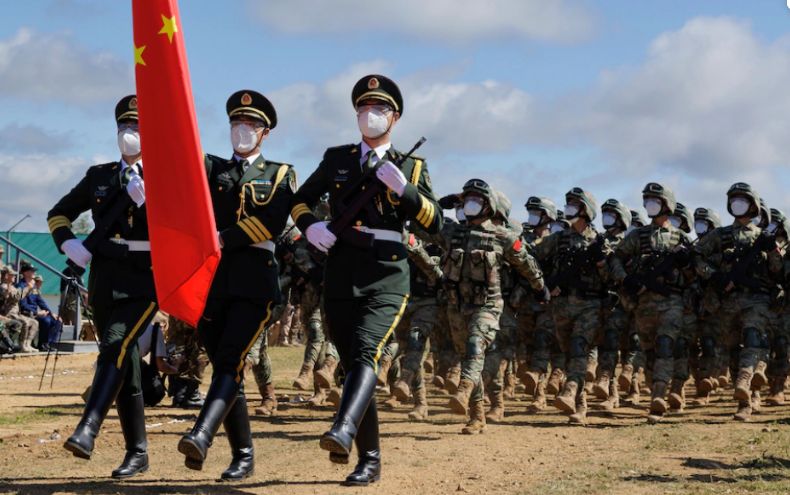
Like Thailand, the
South Koreans don’t want to get caught in the crossfire between China and the United
States, said Markus Garlauskas, director of the
Atlantic Council’s Indo-Pacific Security Initiative and a former national
intelligence officer for North Korea in the U.S. intelligence community. He
noted a Korean saying: “When whales fight, a shrimp’s back gets broken.”
Home to more than
28,000 U.S. troops, South Korea in recent years has shown a willingness to
align itself more clearly with the United States than it did in previous years,
analysts say. In December, for instance, South Korea issued an Indo-Pacific
strategy that didn’t mention China, echoing similar strategies that the United
States, Japan, and Australia issued. Opinion polls show that public sentiment
has turned against China in recent years, as Koreans felt “bullied” by Chinese
economic retaliation in 2017 after installing a U.S. antimissile
battery in response to threats from North Korea, Garlauskas
said.
Seoul views
increasing cooperation with the United States and Japan, in both exercises and
communication, as a key part of assuring the public about South Korea’s
security, a senior South Korean official said. Its Defense Ministry announced
it would hold a one-day tabletop nuclear exercise at the Pentagon this week.
India, which will
host this year’s Group of 20 meeting of the world’s leading economies and
aspires to great-power status in its own right, has come to view China as its
principal adversary following several years of violent border clashes with
Chinese troops that have caused fatalities on both sides. That has pushed New
Delhi closer to Washington.
President Biden,
center, Secretary of State Antony Blinken, left, India's Minister of Defense
Rajnath Singh, right, and Secretary of Defense Lloyd Austin take part in a
virtual meeting with India's Prime Minister Narendra Modi.
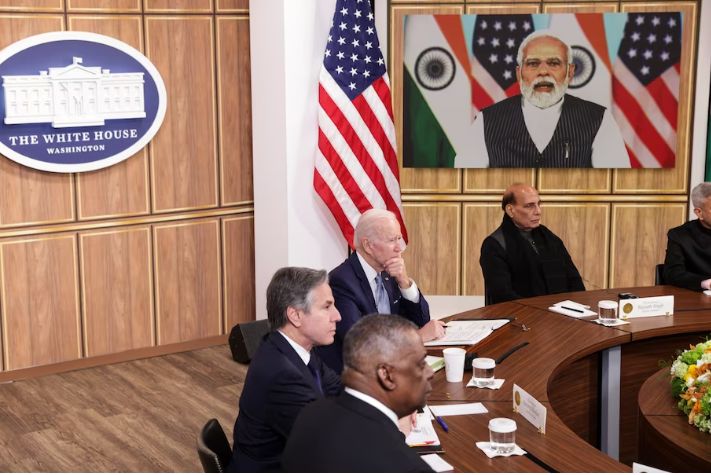
Just last month,
Washington and Delhi held the inaugural meeting of a strategic partnership
announced in May by Biden and Indian Prime Minister Narendra Modi that
encourages their domestic industries to develop artificial intelligence, jet
engines, and semiconductors jointly. And last year, in a first, a U.S. Navy
ship arrived in India for repairs — a significant step for the Indian
shipbuilding industry and the bilateral defense relationship. This cooperation
comes against the intensification of U.S.-India military exercises over the
last several years.
“India, for its
reasons, has now decided to become part of a broader set of balancing
coalitions against China in the Indo-Pacific,” said Ashley Tellis,
an India expert at the Carnegie Endowment for International Peace.
But while India is
happy to receive technical assistance and conduct joint military exercises,
both of which help it develop its capabilities, “they do not want to convey to
anyone, including the Chinese, that there is somehow a U.S.-India alliance
against China,” Tellis added.
Biden administration
officials often hold the Quadrilateral Security Dialogue, or “the Quad,” as an example of their Indo-Pacific strategy
taking hold. Formed by Japan, Australia, India, and the United States as an ad
hoc effort to coordinate humanitarian relief during the devastating 2004 Indian
Ocean tsunami, it languished for years, then was revived during the Trump
administration, and has since evolved to serve as a geopolitical counterweight
to China. Beijing has accused the four countries of seeking to form an “Asian
NATO,” though the partnership lacks a mutual defense commitment.
And while Japan and
Australia are crucial to any U.S.-led regional effort to deter China from
invading Taiwan, India has few direct equities there.
“They wish the
Taiwanese well, but they’re not going to come to their rescue,” Tellis said.
A key variable is Seoul.
“Whether South Korea supports Taiwan or remains neutral could play a huge role
in whether or not China chooses to pursue aggression against Taiwan,” Garlauskas said, noting the United States has military
forces stationed on the Korean Peninsula that could reach the Chinese mainland.
When it comes to the
rest of the allies and partners, the difference between countries such as Japan
and Australia on the one hand and Thailand and Indonesia on the other is that
the former feels a “very clear sense of direct threat” from China, said
Christopher B. Johnstone, a former White House director for East Asia who is
now with the Center for Strategic and International Studies.
Japan has seen a
decade of Chinese aggression over the Senkaku islands, administered by Tokyo
but over which Beijing lays claim. In August, as part of military drills in
response to Pelosi’s visit, China fired ballistic missiles over Taiwan that
landed in waters off Japan, in its exclusive economic zone. Australia has been
on the receiving end of China’s efforts to weaponize economic ties, slapping
draconian tariffs on coal, wine, and other goods after Australia’s prime
minister early in the coronavirus pandemic called for a global inquiry into the
virus’s origins.
Putting Quills On The Porcupine
In recent weeks,
Australian officials say that Canberra and Beijing have tried to stabilize
their relationship. However, that will not undermine Australia's deepening
security partnerships with the United States, Britain, and other allies.
“[F]or Australia, the
sense of China as a bully that seeks to intimidate its neighbors — that became
much more visceral over the last few years,” Johnstone said.
Meanwhile, with much
of Southeast Asia and Oceania, “none of them are choosing China,” Green said.
“They’re just trying to stay out of the fray as best they can.”
Officials say that
improving the U.S. military’s capabilities in the region increasingly depends
on cooperation from allies and partners. In particular, China’s growing arsenal
of precision-guided missiles threatens the U.S. Air Force in the region.
Deployed And Dispersed
Underneath two U.S.
Air Force B-1B strategic bombers, right, South Korean Air Force F-35 fighter
jets, bottom, and U.S. Air Force F-22 stealth fighter jets flying over the
Yellow Sea between China and the Korean Peninsula during a joint air drill.
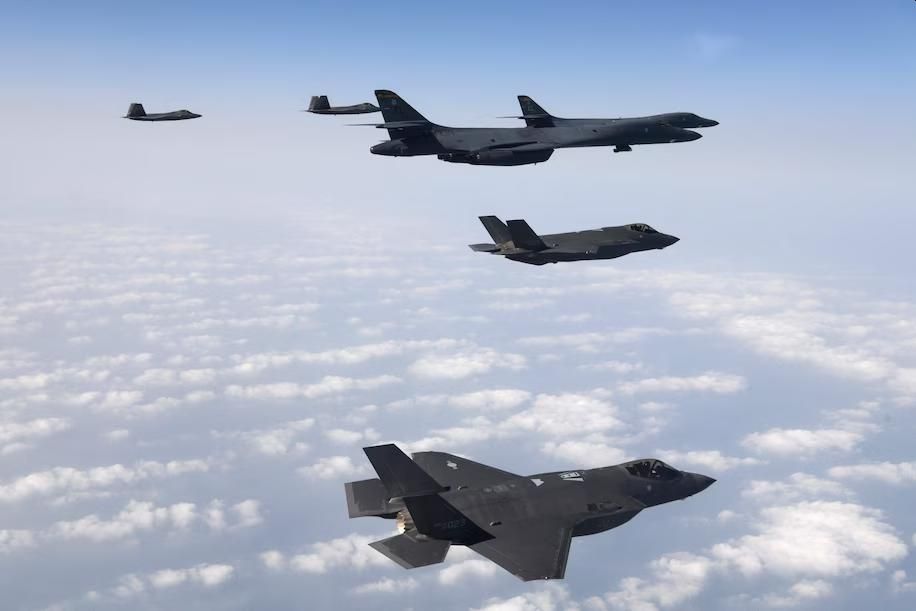
“If you have all of
your aircraft in a few huge bases, and they shut the airfield down, then you
can’t get airborne,” said Gen. Kenneth Wilsbach, U.S.
Pacific Air Forces commander.
The service has been
shifting from large, centralized bases to networks of smaller airfields
dispersed around the region at sites hosted by partner nations, including
Japan, the Philippines, and Micronesia.
Under the “agile combat
employment” strategy, the Air Force operates temporarily out of an airfield in
Palau, shuttling personnel and aircraft as needed. It has been lengthening
runways and positioning munitions, food, and water at regional sites.
In a recent
interview, David Panuelo, Micronesia’s president,
said that the United States was upgrading an airfield and seaport on his
country’s island of Yap, intending to prevent war with China, not starting one.
“We do that through a deterrent,” he said.
Panuelo said he believed Washington’s efforts in the region
were beginning to have an effect. “Pacific nations are looking at the alignment
of their relationships,” he said, citing a failed Chinese effort last year to
reach a regional security pact and other recent setbacks for Beijing.
The service has been
shifting from large, centralized bases to networks of smaller airfields
dispersed around the region at sites hosted by partner nations, including
Japan, the Philippines, and Micronesia.
Under the “agile
combat employment” strategy, the Air Force operates temporarily out of an
airfield in Palau, shuttling personnel and aircraft as needed. It has been
lengthening runways and positioning munitions, food, and water at regional
sites.
David Panuelo, Micronesia’s president, said in a recent interview
that the United States was upgrading an airfield and seaport on his country’s
island of Yap to prevent war with China, not starting one. “We do that through
a deterrent,” he said.
Panuelo said he believed Washington’s efforts in the region
were beginning to have an effect. “Pacific nations are looking at the alignment
of their relationships,” he said, citing a failed Chinese effort last year to
reach a regional security pact and other recent setbacks for Beijing.
The U.S. military is
also seeking to gain access to more locations in the region.
This month Manila
announced it had granted the United States access to four new Philippine
military sites, bringing the total to nine in the archipelagic nation.
Officials did not specify what types of bases — Army or Navy, for instance —
and said announcements of exact sites awaited negotiations with local
officials. However, officials said at least two of the four are expected to be
on the island of Luzon, whose northernmost tip is just a couple hundred miles
from Taiwan.
China’s aggressive
response to Pelosi’s visit last summer, Russia’s invasion of Ukraine, and
Chinese leader Xi Jinping’s securing of a third term have sparked a realization
in Taiwan that the self-governing island needs to be better prepared to defend
itself in the event of a conflict.
Tourists look on as a
Chinese military helicopter flies past Pingtan Island
in Fujian province, one of mainland China's closest points to Taiwan.
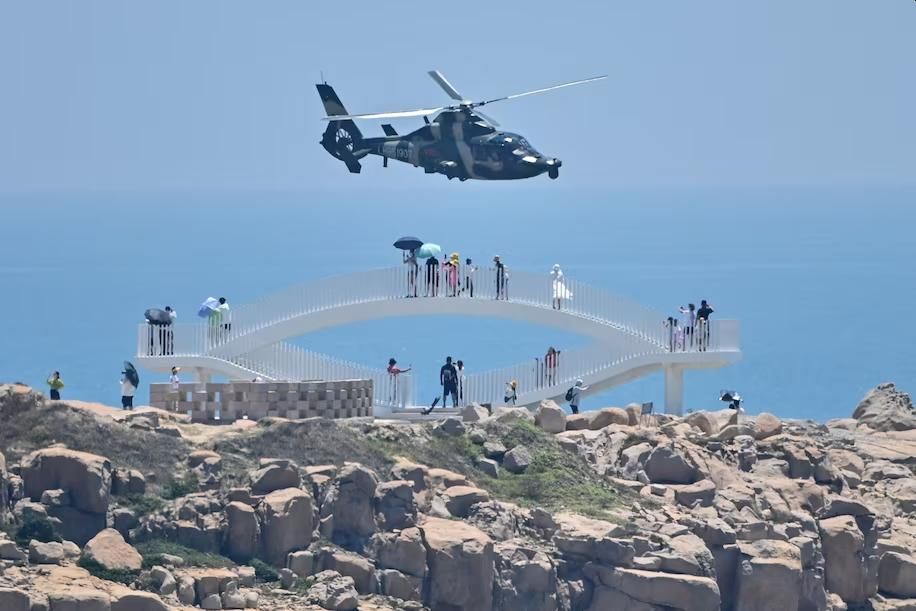
Taiwanese President
Tsai Ing-wen has extended compulsory military service from four months to one
year. But that isn’t enough, argue experts, who, when speaking of Taiwan’s
defense, say that it needs to resemble a porcupine bristling with quills —
boasting a variety of nimble weapons systems that would make it dangerous to
would-be attackers.
But the Taiwanese
military is “still stuck on the idea of fighter jets, warships, and tanks,”
said retired Adm. Lee Hsi-ming, Taiwan’s top military
leader from 2017 to 2019.
Like U.S. military officials
and defense experts, Lee wants to see Taiwan focus more on less costly, more
mobile weaponry — such as anti-ship cruise missiles and naval mines — that can
nonetheless inflict pain on an adversary and more readily survive Chinese
attacks.
“Suddenly asking them
to spend less on tanks and more on Javelins or Stingers — it’s not an easy
change to make,” Lee said, referring to the shoulder-fired missiles that proved
critical in helping Ukraine stop Russian forces from taking Kyiv.
Lee argued that Taiwan
would benefit from a demonstration of intent from Washington about its
readiness to defend Taiwan in a conflict. President Biden has publicly affirmed
on at least four occasions that the United States would come to Taiwan’s
defense. However, Washington’s official policy remains one of “strategic
ambiguity” — designed to keep China guessing about whether an island invasion
would see the U.S. military enter the fray.
Harpoon A-84
anti-ship missiles and AIM-120 and AIM-9 air-to-air missiles are prepared for
weapons-loading drills in front of an F-16V fighter jet at the Hualien Airbase
in Taiwan.
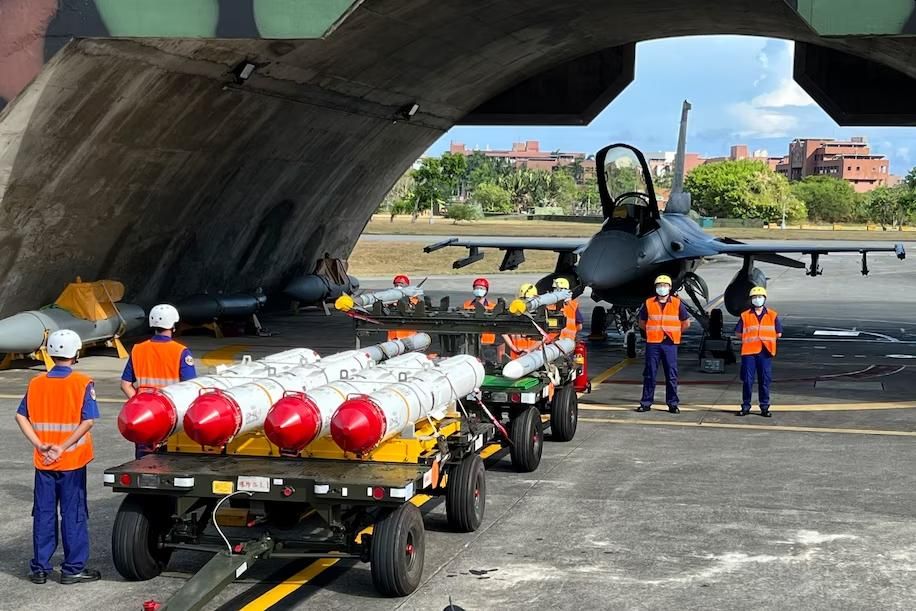
“You need to show
China that preparations are taking place,” Lee said. “It can’t just be empty
talk.”
U.S. commanders
agree.
'The stronger Taiwan
is all the way around, the higher the deterrent value that is, and the greater
the chance we have that China will decide that now is not the time” to invade,
said Wilsbach.
CIA Director William
J. Burns said this month that his agency had intelligence indicating that Xi
has directed the People’s Liberation Army to be capable of a successful
military invasion of Taiwan by 2027, when the PLA will mark its centennial.
However, he hastened to add that it doesn’t mean China’s president will order
one.
Still, Lee said
that’s a valuable milestone against which Taiwan should pace its defensive
preparations. “[T]he intricate complexity of cross-strait relations means that
for Taiwan, it’s not so important to pay close attention to 2024, 2025, or
2027. The most important thing is determining how soon we can be ready.”
The backlogged U.S.
defense production system is also a major challenge; experts noted, now
stretched even tighter by the war in
Ukraine. “Look at how
we have been buying F-16s for five or six years, but we still don’t have them,”
Lee pointed out. “What can we do to deter China and defend ourselves
immediately? That’s where we need to be investing.”
U.S. Defense Secretary
Lloyd Austin, left, shakes hands with South Korean Defense Minister Lee
Jong-sup after a news conference following their meeting in Seoul on 31 Jan.
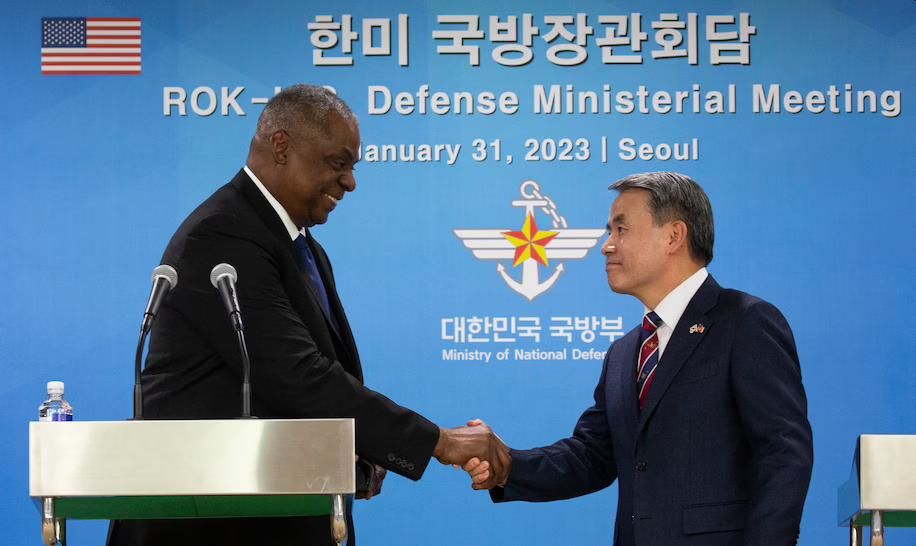
U.S. capabilities
need to advance, too, Aquilino said. One of the things he’s pushing for is
advanced long-range missiles that can be launched from air or sea to take out
an adversary’s ships in the region.
Back in his office, overlooking
the military base that was the site of a catastrophic surprise attack more than
eight decades ago for which the U.S. military was not prepared, Aquilino is
determined that the United States not witness another Pearl Harbor.
Much has changed since
then. The U.S. military holds more than 100 exercises with countries in the
Indo-Pacific each year. Aquilino commands 375,000 troops and civilians in the
region. And, after China, the top five economies in the region are all
democracies.
But Beijing, developing
advanced hypersonic missile capabilities and on course to have 1,500 nuclear
weapons in the next decade, is threatening to destabilize what Aquilino calls
the “rules-based order” that has enabled nations “over the past eight decades
to be secure, sovereign, prosperous.''
Defense Secretary
Lloyd Austin has given him two missions, he said. The first: is to do
everything in his power to avoid a war in the Pacific. “We spend a lot of time
working to prevent that conflict,” he noted.
The second mission,
if it comes to war, is to fight and win. “If deterrence fails,” Aquilino said,
“Indo-Pacom is prepared to do that mission as well.”
For updates click hompage here